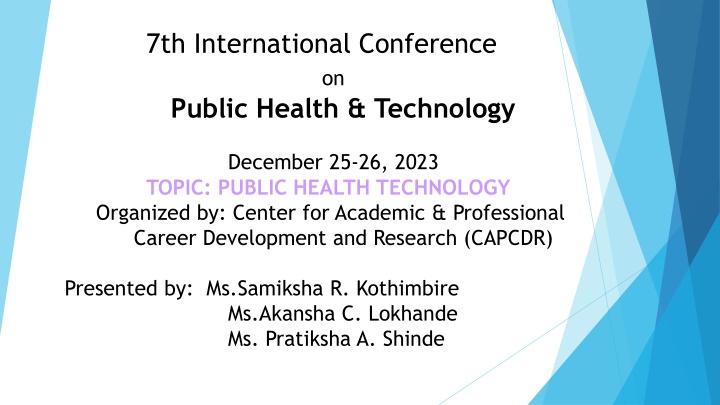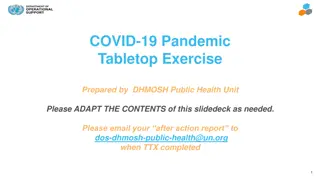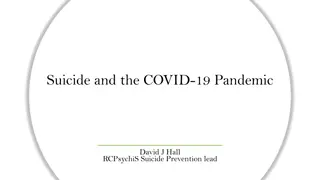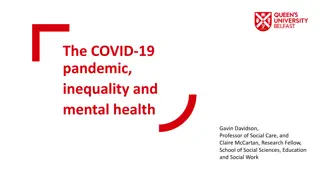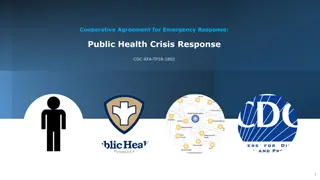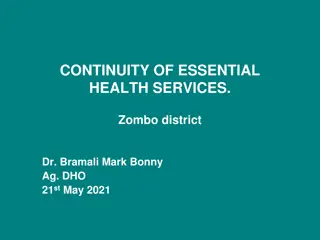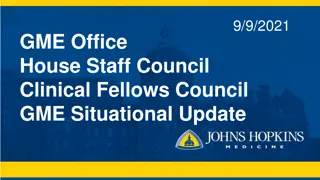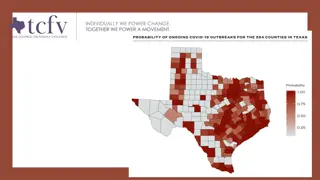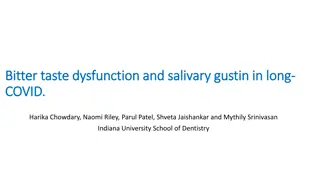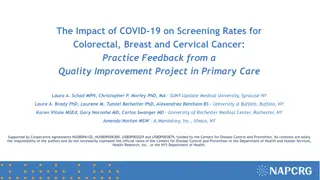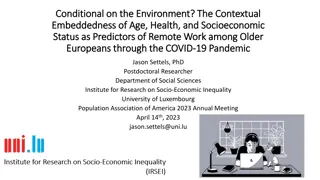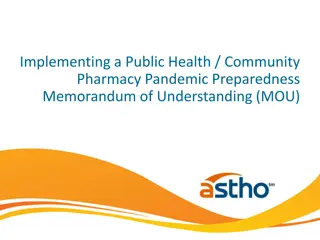Enhancing Public Health Technology: Lessons from the COVID-19 Pandemic
The COVID-19 pandemic revealed gaps in healthcare, particularly in public health technology. This blog discusses the importance of leveraging technology in public health, improving digital equity, ethics in data usage, and preparing future healthcare professionals. Emphasizing the intersection of humanity, technology, and data in providing innovative solutions for public health challenges.
Download Presentation

Please find below an Image/Link to download the presentation.
The content on the website is provided AS IS for your information and personal use only. It may not be sold, licensed, or shared on other websites without obtaining consent from the author.If you encounter any issues during the download, it is possible that the publisher has removed the file from their server.
You are allowed to download the files provided on this website for personal or commercial use, subject to the condition that they are used lawfully. All files are the property of their respective owners.
The content on the website is provided AS IS for your information and personal use only. It may not be sold, licensed, or shared on other websites without obtaining consent from the author.
E N D
Presentation Transcript
7th International Conference on Public Health & Technology December 25-26, 2023 TOPIC: PUBLIC HEALTH TECHNOLOGY Organized by: Center for Academic & Professional Career Development and Research (CAPCDR) Presented by: Ms.Samiksha R. Kothimbire Ms.Akansha C. Lokhande Ms. Pratiksha A. Shinde
The COVID-19 pandemic highlighted the many gaps in the American healthcare system, but perhaps one of the most apparent was the use of public health technology. In this blog I am joined by Neil Maniar, Director of Bouv College of Health Sciences Master of Public Health Program, to discuss what we learned about public health technology throughout the pandemic, what needs to be done to improve and advance it, and how we re preparing our students to be the next generation of healthcare professionals. the science of public health is taking knowledge and applying it to real-world settings to protect and improve the health of people and the communities where they live. public health technologies data science, machine learning, apps utilizing artificial intelligence, connected health, etc. are becoming more prevalent in the practice of public health. We saw an accelerated adoption of these technologies during the COVID-19 pandemic. These technologies are becoming part of the day-to-day delivery of healthcare so it s important to understand not only how they can be integrated into the work we do, but how technology can be accessed and leveraged to tackle the long-standing disparities, said Maniar.
Throughout the COVID-19 pandemic, it was clear that public health systems, processes, and professionals were not as up to date as needed. Our ability to rapidly and effectively respond to the pandemic was hindered because the integration of technology can be viewed as two separate but intersecting pathways. The first is making sure public health professionals have the proper skill sets and the right opportunities to develop the most state-of-the-art skills. The second is making sure we re preparing the next generation of healthcare professionals to understand the importance of fully leveraging digital technology to lead innovation and to address our most deeply rooted public health issues, because skill sets, opportunities, and mindsets are intertwined. nothing is more impactful than public health. To improve public health and its technologies, we must think of humanity, technology, and data and how they intersect and work toward providing problem-based solutions. While public health technologies are necessary for our future, Maniar says there are several things that we need to change so we can make the most of the technology available. First is the readiness of organizations and communities to be able to adopt these technologies. we need to prioritize improving digital equity, something that was vividly highlighted throughout the pandemic. This means ensuring communities have the proper infrastructure to support tech innovation and addressing the gaps that exist, i.e., having high-speed broadband, digital literacy, and ensuring that all are able to use it. We also have to acknowledge the ethical issues in terms of data generated and what s done with those data and making sure we re continuing to honor and build trust with individuals and communities, said Maniar. Making sure we re putting ethical use of technology at the forefront of what we do. by making sure things are equitable and by addressing the needs of all individuals and all populations comes the opportunity to innovate. through our Northeastern University ecosystem, we re able to bring together talents and sectors that need to be in the public health conversation so we can truly transform the landscape to help people live healthy lives. Focusing on public health technology aligns with the mission of Bouv and healthspan, ensuring individuals can reach their optimal health, said Maniar. It really embodies the interdisciplinary approach we have in Bouv , to do it and do it well, collaborating with different areas in health sciences, population health, etc.
our students have a range of opportunities, from capstones to practicums, to work with health technology companies and organizations to see how the tech is used to understand outbreaks. This knowledge helps us better respond to a public health crisis. as a direct response to seeing the importance of the field within the practice of public health, Bouv is launching a new concentration in public health technologies, making us one of the few schools in the country that has this innovative focus area. This embodies the innovative spirit of Northeastern and provides a big opportunity across Bouv to really push the envelope in terms of innovation and in terms of how we think about technology in public health, said Maniar. maniar reminds us that public health is not in isolation, it is in collaboration with communities. At Bouv , we re looking forward to further harnessing this great work and opening new opportunities for the Bouv community, our students, and the communities we serve as we strive for global impact in society. What is Public Health? The World Health Organisation defines public health as the art and science of preventing disease, prolonging life and promoting health through the organised efforts of society. Advances in public health technology have made a huge impact on global health. As various issues arise in society, so does the need for different public health solutions. Looking to the future is important in health care. Governments set long-term goals to protect and improve the quality of health of their citizens. The use of technology is important as it can have both risks and benefits to health. Why is Public Health Important? Public health is important because it addresses the various health risks which can arise over time throughout populations. The most prevalent of these health risks include diseases, which was recently seen on a global pandemic scale with the COVID-19 virus.
What are the Benefits of Technology in Healthcare? Data and medical devices can greatly help us understand health on a large scale. The Internet of Things (IoT) can help us understand health factors and how to combat issues in the future in a more preventative way. Scientific discoveries have greatly helped modern medicine advance forward and the impact of technology on public health is extremely significant in improving quality of life for people around the world. How is Technology Used in Healthcare? Technology is used in a number of ways to support public health professionals and advance the sector into more effective solutions. Data analytics is another way that we can not only predict health issues in people but also understand how to better tackle issues. Data analytics means introducing new software or medical devices that use information from a patient to deliver a diagnosis or prognosis, allow for earlier interventions, and provide a more personalised treatment plan.
What are the New Technologies in Public Health? Some of the new technologies being utilised in healthcare are Virtual Reality and Augmented Reality. This is used usually to deliver staff training so they can experience a real-life scenario in a believable way. This technology is also used to aid in psychological treatments like exposure therapy. Website information is another way to help educate and share the latest health information. As we saw with the COVID-19 pandemic, research and understanding of the disease changed with each day. The Internet was a way for experts to share information with the public to better protect themselves. Applications are also being used in healthcare to both support and track patients progress through an illness. For example, diabetics can use an application to access their own medical records as well as monitor and manage their medical condition more effectively.
